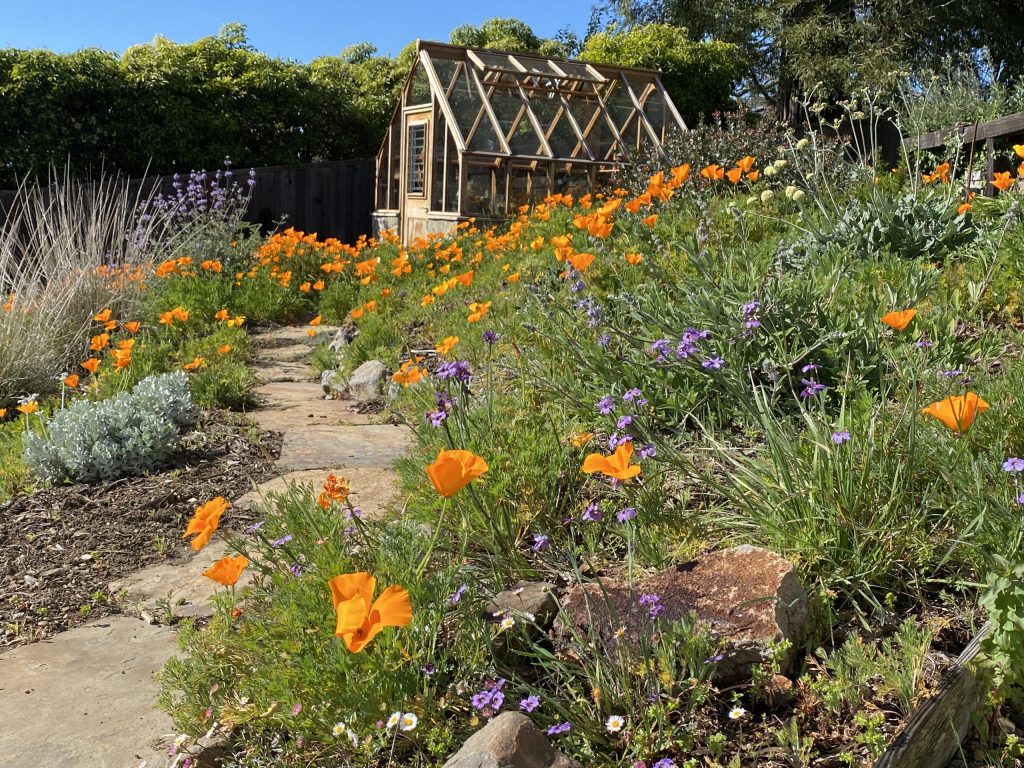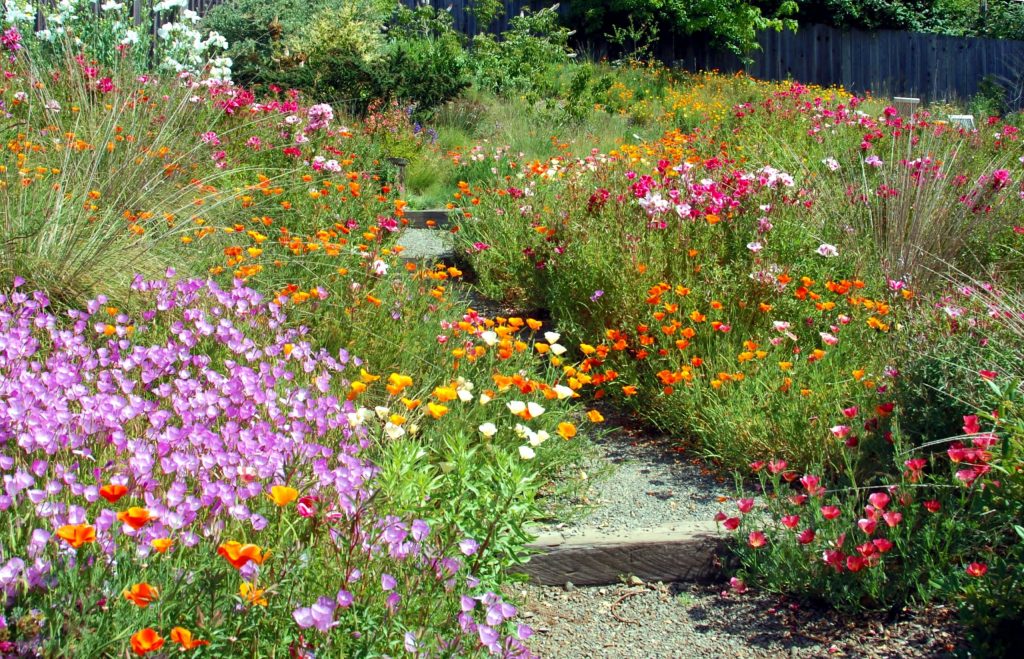
Spring is prime bloom time in California native plant gardens. Photo by Allison Kidder
What if, with one fell swoop, you could support wildlife, provide yourself with beautiful daily scenes of birth and regrowth, all while using barely any resources or water? Well, you can, by planting even just one California native plant.
According to survey results recently released through University of California Davis and UC Agriculture and Natural Resources, the large numbers of people who gardened during the pandemic did so to increase their personal food security and to serve as an antidote to anxiety. While the mental health benefits of gardening are well-established, these gardens can also include plants well-suited to California’s ecology and water cycle.
Dr. Lucy Diekmann, the University of California Cooperative Extension Urban Agriculture/Food Systems Advisor for Santa Clara and San Mateo Counties, one of the survey’s authors, saw an opportunity to learn why gardening became such an important activity for people during the pandemic. “We were noticing all of the buzz about gardening and thought it would be so interesting to dig into this new trend more.” The results of the survey indicate people turned to gardening during the pandemic to relieve anxiety and stress, find a safe place to spend their time, and gain a sense of control and security from growing their own food.
But not everyone grew food. “About 72% of respondents said they were growing ornamentals”, says Diekmann. With the increase in gardening that includes water-intensive ornamentals and vegetable gardens it is important to consider the implications for our water supply.

A colorful array of California poppies (Eschscholzia californica) and clarkia (Clarkia sp.) wildflowers complement sprays of deer grass (Muhlenbergia rigens). Photo by Pete Veilleux, East Bay Wilds.
The combination of needing to supply water to a population that has grown by almost 80 percent since the severe drought of 1976-77 and the increasingly hotter and drier climate occurring with climate change creates an urgent need to modify our water use. In a 2022 study published by the journal Nature Climate Change, researchers used tree cores from different sites across the West to compare the current drought to historical ones. They found that California is in the midst of its driest 22-years on record.
In a future with long droughts and precious water, gardeners can get their fix by turning to California native plants. These plants fit the bill perfectly because they have evolved to live with the rainless summers of our Mediterranean climate and have physiological traits that enable them to reduce water losses to the atmosphere.
Manzanita species have leaves that point toward the sun that reduce the leaf surface area that receives direct sunlight. Many California fuchsias, which provide rare color in the native plant garden during fall, have light gray or gray-green leaves that reflect sunlight and allow the leaves to stay cooler than green leaves, enabling the plant to retain water even on warm days. Plants have other water-saving strategies, including the presence of hairs that prevent wind from drying out a leaf or leaves with a waxy cuticle that prevents water from escaping. A good resource for finding more drought-tolerant native plants that will thrive in your neighborhood is the California Native Plant Society’s Calscape database.
The City of Santa Monica’s demonstration garden compared water use for nine years between a garden with native plants and a garden with traditional ornamental plants and found the native plant garden used 83 percent less water than the traditional garden. During the 2005-2006 water year alone, the demonstration landscape with water-hungry ornamentals and a lawn used 57,000 gallons of water per year whereas the native-dominated landscape used 6,000 gallons per year. And as a bonus, the native plant garden decreased the amount of maintenance by 68 percent and decreased the amount of green waste by 56 percent.

Pipevine Swallowtail (Battus philenor) on California Fuchsia (Epilobium canum) at the East Bay Regional Parks Botanic Garden. Photo by Minder Cheng
California natives and other ecologically productive plants support more caterpillars than lawns and ornamentals, particularly if you include host plants for butterflies and moths in your neighborhood. According to Doug Tallamy, Professor of Entomology and Wildlife Ecology at University of Delaware, 16 out of 20 bird families depend on feeding caterpillars to their nestlings (other bird families, such as doves and finches, rely on seeds). In the case of a chickadee species found on the East Coast, it takes an astounding 6,000-9,000 caterpillars to raise one clutch of nestlings.
It turns out caterpillars are an integral piece of our backyard food web: they eat the plants and the birds eat the nutrient-rich caterpillars. Tallamy says “keystone plants” comprise 14% of our native plants while making 90% of the caterpillar food that drives food webs. Oak trees (Quercus sp.) are the big winner, supporting 271 species of caterpillars in California. Even a few plants in a single container adds biodiversity and wildlife support, and attracting pollinators helps vegetable gardens too.
Gardeners who responded to the UC Davis survey have been getting the message. “There was a lot of interest in habitat creation,” says Diekmann. “There was an interest in using native plants and other plants to create habitat for different types of organisms that people view as beneficial.”
She says that when respondents were given the chance to describe what they were growing, many people wrote they were planting natives with a focus on habitat. One gardener wrote they were growing “California native plants and Mediterranean plants with high habitat value.” Another provided this detail, “While sheltering in place I found online nurseries that would ship native plants to me. This opened up a whole new world for me to find native plants.”

Perennials can provide predictable color and showy foliage. Here, a variety of buckwheats (Eriogonum umbellatum var. polyanthum ’Shasta Sulfur’, Eriogonum grande var. rubescens, and Eriogonum crocatum) join several low-growing and upright manzanitas (Arctostaphylos nummularia ‘Bert Johnson’, Arctostaphylos ‘Mt Saint Helens’, and Arctostaphylos pajaroensis ‘Warren Roberts’) to provide almost year-round color. Photo by Pete Veilleux, East Bay Wilds.
That respondent is not alone in a new interest in native plants. Enter Kathy Kramer, a landscape consultant who will be hosting her eighteenth Bringing Back the Natives Garden Tour this month. According to Kramer, “many more new people, about 1,000 new registrants” signed up for the tour when the pandemic began. “This is higher than in previous years,” she says.
The tour allows participants to walk behind numerous side gates to view gardens containing a minimum of 70 percent native plants and witness the pageantry of a springtime garden full of California natives. These outlets of creativity and hard labor are all located in Alameda and Contra Costa Counties but the plants grown in these gardens are applicable to all nine Bay Area counties. This year’s tour is happening April 16 and 17, featuring a presentation on the value of oaks by Doug Tallamy on April 16 and virtual garden tours both days, and self-guided in-person tours of coast and island gardens on April 30 and May 1, respectively.
South Bay and the Peninsula area residents can attend the Growing Natives Garden Tour, which has been hosting native plant garden tours in these areas since 2003. This year’s tour occurred April 2 and 3 but people can register to attend, volunteer, and submit their native plant garden containing 70 percent or more native plants for inclusion in next year’s tour on their website.
Nurturing a garden provides a sense of purpose, both for humans and wildlife alike. As we face the harsh and often scary realities of climate change we still have a chance to slow the trend by changing our behavior, including changing the spaces outside our homes to benefit wildlife using drought tolerant native plants. We can easily connect to our sense of place, like our closest open space, and that plant that we always look forward to seeing on the trail can now exist on the way out our front door.

